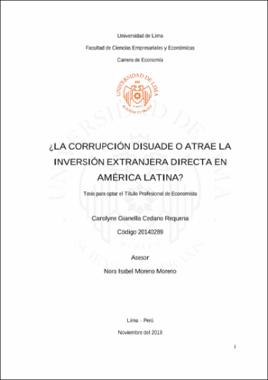Mostrar el registro sencillo del ítem
¿La corrupción disuade o atrae la inversión extranjera directa en América Latina?
| dc.contributor.advisor | Moreno Moreno, Nora Isabel | |
| dc.contributor.author | Cedano Requena, Carolyne Gianella | |
| dc.date.accessioned | 2020-03-10T13:47:20Z | |
| dc.date.available | 2020-03-10T13:47:20Z | |
| dc.date.issued | 2019 | |
| dc.identifier.citation | Cedano Requena, C. G. (2019). ¿La corrupción disuade o atrae la inversión extranjera directa en América Latina? (Tesis para optar el Título Profesional de Economista). Universidad de Lima. | es_PE |
| dc.identifier.uri | https://hdl.handle.net/20.500.12724/10559 | |
| dc.description.abstract | En un entorno en el que la competitividad por atraer inversión extranjera es cada vez mayor, el creciente interés en la literatura por determinar la relación ente la corrupción y la IED, ha dado lugar a dos teorías contrarias. La primera indica que la corrupción se puede comportar un incentivo a la IED y la segunda como un elemento disuasivo. Sin embargo, existen aspectos teóricos como la endogeneidad de las variables, la relación de largo plazo y la diferencia entre flujos y stocks de la IED, en los que no se ha profundizado en América Latina. En ese sentido, el presente estudio tiene como propósito determinar si la corrupción ha tenido un efecto positivo o negativo en la atracción de la IED de América Latina, para el periodo de 1998 – 2017. Específicamente, busca identificar si existe una relación de doble causalidad entre las variables. Asimismo, determinar si el efecto de corto plazo, difiere del de largo plazo y finalmente, comprobar si el resultado varía dependiendo de si emplea los flujos o el stock de IED para medir el efecto. Mediante un panel data estático, los resultados sugieren que el impacto de la IED ha sido negativo. Así, un incremento en 1 unidad en el rezago de la corrupción generaría una caída de en la IED entre 11% y 38%. A su vez, mediante un panel VAR y la prueba de causalidad de Granger, se ha encontrado evidencia de una relación bilateral entre dichas variables y la ausencia de una relación a largo plazo. De la misma manera, lo encontrado podría sugerir que usar los stocks de IED para medir el impacto de la corrupción en la IED de la región, podría llevar a resultados erróneos y contradictorios, puesto que la metodología para estimarla varía mucho entre países. | es_PE |
| dc.description.abstract | In an environment in which the competitiveness to attract foreign investment is growing, the interest in literature to determine the relationship between corruption and FDI has given rise to two contrary theories. The first indicates that corruption can behave as an incentive to FDI and the second as a deterrent. However, there are theoretical aspects such as the endogeneity of the variables, the long-term relationship and the difference between FDI flows and stocks, in which Latin America has not deepened. For this reason, the present study aims to determine whether corruption has had a positive or negative effect on the attraction of FDI in Latin America, for the period 1998 - 2017. Specifically, it seeks to identify if there is a double causality relationship between the variables. Also, determine whether the short-term effect differs from the long-term effect and finally, check whether the result varies depending on whether you use the flows or the stock of FDI to measure the effect. Using a static data panel, the results suggest that the impact of FDI has been negative. Thus, an increase in 1 unit in the lag of corruption would generate a drop in FDI between 11% and 38%. In turn, through a VAR panel and the Granger causality test, evidence has been found of a bilateral relationship between these variables and the absence of a long-term relationship. In the same way, the findings could suggest that using FDI stocks to measure the impact of corruption on FDI in the region could lead to erroneous and contradictory results, since the methodology for estimating it varies widely between countries. | en_EN |
| dc.description.uri | Tesis | es_PE |
| dc.format | application/pdf | |
| dc.language.iso | spa | |
| dc.publisher | Universidad de Lima | |
| dc.rights | info:eu-repo/semantics/openAccess | * |
| dc.rights.uri | https://creativecommons.org/licenses/by-nc-sa/4.0/ | * |
| dc.source | Repositorio Institucional - Ulima | es_PE |
| dc.source | Universidad de Lima | es_PE |
| dc.subject | Investments, Foreign | en_EN |
| dc.subject | Corruption | en_EN |
| dc.subject | Latin America | en_EN |
| dc.subject | Inversiones extranjeras | es_PE |
| dc.subject | Corrupción | es_PE |
| dc.subject | América Latina | es_PE |
| dc.title | ¿La corrupción disuade o atrae la inversión extranjera directa en América Latina? | es_PE |
| dc.type | info:eu-repo/semantics/bachelorThesis | |
| thesis.degree.level | Título Profesional | es_PE |
| thesis.degree.discipline | Economía | es_PE |
| thesis.degree.grantor | Universidad de Lima. Facultad de Ciencias Empresariales y Económicas | es_PE |
| dc.publisher.country | PE | |
| dc.type.other | Tesis | |
| thesis.degree.name | Economista | es_PE |
| renati.advisor.orcid | https://orcid.org/0000-0003-2214-6863 | |
| renati.discipline | 311016 | |
| renati.author.dni | 76548320 | |
| renati.level | https://purl.org/pe-repo/renati/level#tituloProfesional | * |
| renati.advisor.dni | 08192728 | |
| renati.type | https://purl.org/pe-repo/renati/type#tesis | * |
| dc.subject.ocde | https://purl.org/pe-repo/ocde/ford#5.02.01 | |
| ulima.cat | OI |
Ficheros en el ítem
Este ítem aparece en la(s) siguiente(s) colección(ones)
-
Tesis [127]



